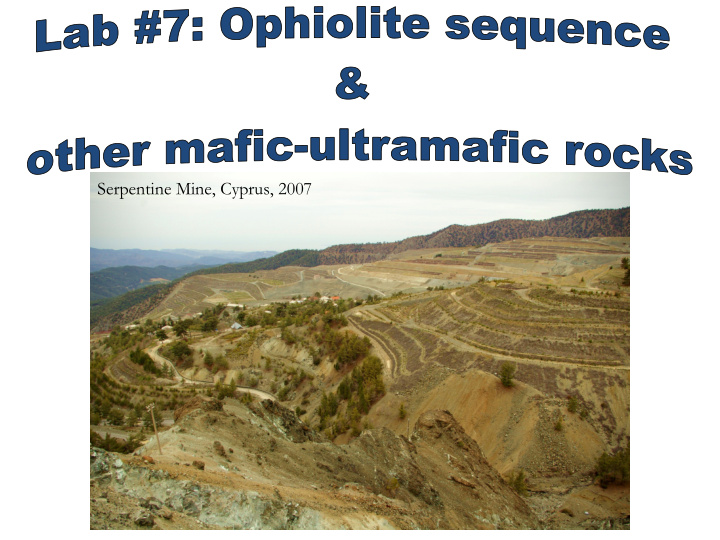



Serpentine Mine, Cyprus, 2007
What is an ophiolite? • Simply: Ophiolites are pieces of oceanic crust found on land • The international ophiolite conference restricted the term “ophiolite” to only include the following rock types/assemblages • This definition has been challenged recently due to recent discoveries made by the IODP
New Mineral you need to know: Serpentine Mg 3 Si 2 O 5 (OH) 4 Fibrous/Fine grained mat like Habit 1 st order interference colours Pale Green-yellow pleochroism Serpentine group of minerals (chrysotile, lizardite, and antigorite)
New Mineral you need to know: Talc Mg 3 Si 4 O 10 (OH) 2 Colourless in PPL 2 nd order birefringence Fibrous-bladed habit May be difficult to distinguish from muscovite in thin section easy in hand sample
New Mineral you need to know: Pumpellyite (Mg,Fe 2+ )(Al,Fe 3+ ) 5 Ca 4 O(OH) 3 [Si 2 O 7 ] 2 [SiO 4 ]2.2H 2 O Green Yellow-pleochroism Bladed-radiating habit *most useful Anomalous blue birefringence and yellow-brown birefringence Prehnite Ca 2 Al 2 Si 3 O 12 (OH) commonly associated with pumpellyite NOTE: higher birefringence and more fibrous h bit
New texture you need to know: mesh texture Mesh Texture: Hydrothermal alteration produces a network or serpentine interlaced with original igneous minerals
Particulars… • Full rock description of KHAB 2 OR 331/88/1 (worth ½ the lab!) Good Luck!
Amphibole
Amphibole Anxiety… Ortho-amphiboles Vs. Clino-amphiboles
Amphibole Anxiety: Ortho-amphiboles • There are two common forms of orthoamphibole: Anthophyllite : (Mg,Fe) 2 (Mg,Fe) 5 SiO 22 (OH) 2 Gedrite : (Mg,Fe) 5 Al 2 [Al 2 Si 6 O 22 (OH) 2 ] • Orthoamphibole occurs in metamorphic rock of medium-high grade, but not in igneous rocks. Amphiboles are hydrous minerals which break down in anhydrous environments. • They are not found in mafic and ultramafic igneous rocks because these magmas have little dissolved water. The amphiboles will break down to form pyroxenes instead. • Helpful Hints – Orthoamphiboles have parallel extinction – Maximum interference colours of first order red and second order blue – Brown color of orthoamphibole may be useful in distinguishing it from hornblende, which usually has a green-black color
Amphibole Anxiety: Clino-Amphiboles • Hornblende (Na,K) 0-1 (Ca,Na,Fe,Mg) 2 (Mg,Fe,Al) 5 (Si,Al) 8 O 22 (OH) 2 Name given to an amphibole with an indeterminate composition Ubiquitous mineral in intermediate igneous rocks and amphibolite facies metamorphism • Actinolite Series Ca-rich amphiboles are most common in greenschist-amphibolite facies metamorphism (i.e. meta-carbonates) Tremolite: Ca 2 Mg 5 Si 8 O 22 (OH) 2 White colour in HS; maximum interference colours are upper 1 st order; inclined extinction; large 2V (75-88) Actinolite: Ca 2 (Mg,Fe) 5 Si 8 O 22 (OH) 2 Pale-deep green; negative optic sign • Cummingtonite Series Commonly found in mafic metamorphic rocks at intermediate pressures and temperatures Cummingtonite: (Mg,Fe) 7 Si 8 O 22 (OH) 2 Inclined extinction, twins and higher birefringence distinguish from orthoamphiboles; positive optic sign and occurrence distinguish from actinolite series Grunerite: Fe 7 Si 8 O 22 (OH) 2 Subtle pleochroism when compared to cummingtonite • Glaucophane series: Na 2 Mg 3 Al 2 Si 8 O 22 (OH) 2 Only found in metamorphic rocks (i.e. Blueschist facies) Distinct pleochroism (colourless-medium blue)
Recommend
More recommend